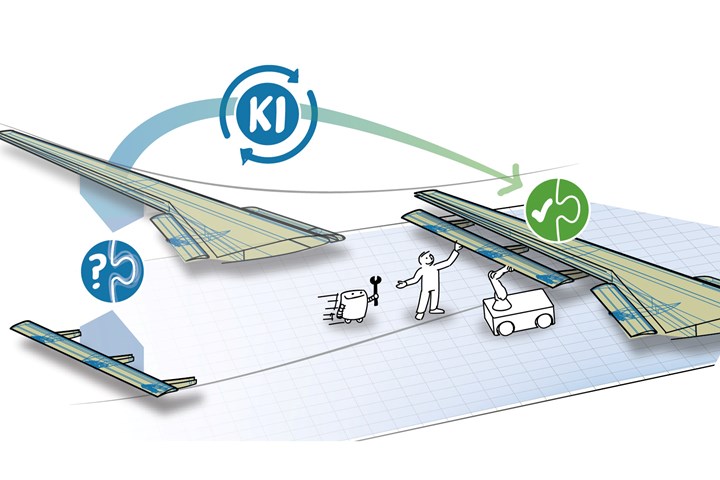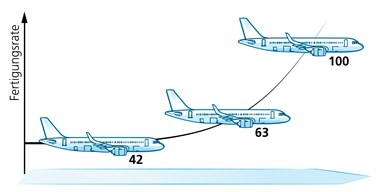DLR develops concept for final assembly line with artificial intelligence
High-rate production enabled by pre-selection of assembly-ready components, without manual compensation measures, based on neural network training.

A final assembly line with artificial intelligence (künstliche intelligenz, or KI) can be implemented, with assemblability guaranteed at all times. Photo credit: article by Dr. Ing. Lennart Weiss, Institute for Composite Structures and Adaptive Systems.
In a 2021 article by Dr. Ing. Lennart Weiss, of the DLR Institute for Composite Structures and Adaptive Systems (Braunschweig, Germany), manual compensation procedures — for example, shimming —and the resulting delays are a thing of the past. Each assembly can be joined immediately using artificial intelligence, because a clever pre-selection of the components reduces excessively large tolerances at the connection areas. Even high-rate production is possible thanks to the “plug and fly” principle. DLR envisions the complete introduction of this expert system into series production.
Independent assembly decision
In an expert system, the artificial intelligence selects individual parts that can be assembled independently. The connection dimensions and their tolerances determine whether the components can be assembled. The neural network evaluates the recorded parameters, draws on its "experience" and signals a positive or negative assembly process. The neural network achieves empirical values through so-called monitored training cycles (supervised learning). This often requires a large number of independent assembly scenarios or data points. The greatest challenge is the limited availability of this training data for assembly processes in the final assembly line.
Computer-aided for small batch sizes
First and second step regression functions, where AI (shown here as KI for künstliche intelligenz) generates the final regression functions.
A two-stage process solves the problem in dealing with small lot sizes. Thefirst step of the process consists of training several neural networks. They represent various preselected approach functions. Their training for the best possible regression of the data points leads to the first "experiences". However, the influence of the preselection of shape functions on the regression result is too great. Therefore, in the second step, the algorithm is free to generate its own approach function based on its “experiences” from the first step and to carry out the training with this again.
The algorithm learns from its training experience and independently determines a regression function that is sufficiently predictive even for small batches. The artificial intelligence runs through this computer-aided process after each assembly, so that the wealth of experience grows with each positive or negative assembly process. This improves the prediction quality of the expert system with each assembly process carried out.

The learning expert system enables economical high-rate production based on the “plug & fly” principle. Complex compensation measures and downtime in the assembly line are a thing of the past. The expert system evaluates, in real-time, specific component information, such as tolerances at joints and provides presettings for guaranteed assembly as a recommendation for action to the assembler. Photo Credit: 2020 article by Dr. Ing. Lennart Weiss, DLR.
The learning expert system accompanies the final assembly line in series production. The knowledge gained can be used both for new flexible assembly concepts in the factory of the future and for a new construction philosophy for the designer of the future.
This article follows on from Weiss’ 2020 article, “Flexible Cooperation - with a learning expert system for intelligent assembly”.
Related Content
Carbon fiber in pressure vessels for hydrogen
The emerging H2 economy drives tank development for aircraft, ships and gas transport.
Read MoreInfinite Composites: Type V tanks for space, hydrogen, automotive and more
After a decade of proving its linerless, weight-saving composite tanks with NASA and more than 30 aerospace companies, this CryoSphere pioneer is scaling for growth in commercial space and sustainable transportation on Earth.
Read MoreThermoplastic composites welding advances for more sustainable airframes
Multiple demonstrators help various welding technologies approach TRL 6 in the quest for lighter weight, lower cost.
Read MorePlant tour: Joby Aviation, Marina, Calif., U.S.
As the advanced air mobility market begins to take shape, market leader Joby Aviation works to industrialize composites manufacturing for its first-generation, composites-intensive, all-electric air taxi.
Read MoreRead Next
CW’s 2024 Top Shops survey offers new approach to benchmarking
Respondents that complete the survey by April 30, 2024, have the chance to be recognized as an honoree.
Read MoreComposites end markets: Energy (2024)
Composites are used widely in oil/gas, wind and other renewable energy applications. Despite market challenges, growth potential and innovation for composites continue.
Read MoreFrom the CW Archives: The tale of the thermoplastic cryotank
In 2006, guest columnist Bob Hartunian related the story of his efforts two decades prior, while at McDonnell Douglas, to develop a thermoplastic composite crytank for hydrogen storage. He learned a lot of lessons.
Read More
















.jpg;maxWidth=300;quality=90)










